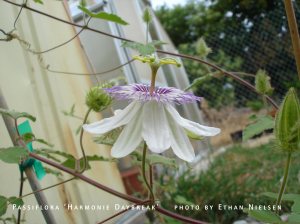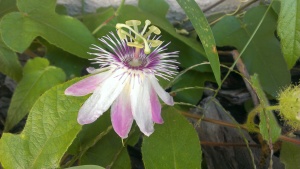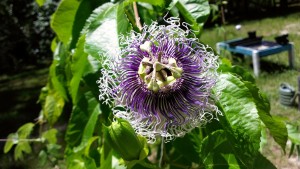I am a graphic designer turned horticultural scientist. I worked for eight plus years as a graphic designer (ethannielsenarts.weebly.com), when a downturn in the economy allowed me to turn my love of plants into something more. I now have a degree in visual arts from BYU, a degree in horticultural science from Utah State University, and I am currently a PhD candidate at University of Florida. I’m also a loving husband and father of four.

Passiflora ‘Harmonie Daybreak’ bred by Ethan Nielsen in 2007, a cross of Passiflora arida with Passiflora sublanceolata.
Officially I am a citrus breeder in training, but I also love many other plants, especially fruiting plants but also those valued for flowers, and especially those valued for both. One of my most enduring passions (besides citrus) is passion flowers or passion fruit, or just Passiflora. I have been cultivating and breeding Passiflora for years, and my first release was Passiflora ‘Harmonie Daybreak’ (named after my wife) in 2007, a cross between Passiflora arida and P. sublanceolata. It was my first attempt, and a breakthrough in that no one had created any P. arida hybrids prior. I no longer have ‘Harmonie Daybreak’, but I do have her offspring, including one I’m about to release called ‘Pinkerella’, a backcross to P. sublanceolata.

A 2013 hybrid, its second ever flower. This is P. sublanceolata crossed with P. foetida ‘Australiana’. I like the alternating colors of the petals.
I have a goal to breed edible passionfruit, using the native U.S. species P. incarnata, which is cold hardy, and crossing it with edible commercial types like P. edulis and P. edulis var. flavicarpa, the purple and yellow types. These species will cross directly and make somewhat fertile hybrids. I am working with some other breeders to collectively work toward this goal. I am also using some other relatives with cold hardiness that can cross with either, namely P. caerulea and P. tucumanensis. I may use some other species, such as P. alata and P. quadrangularis, which can also cross with P. incarnata or P. edulis. This work is still in the beginning stages, although I have created F1 hybrids, and have obtained some F1 and F2 hybrids from other breeders. Let me know if you want to collaborate!

Passiflora ‘Green Tiger’ bred by Ethan Nielsen in 2009, to be released in 2013. This is a cross between Passiflora incarnata with Passiflora ‘Frederick’ (a hybrid between P. edulis and P. edulis var. flavicarpa, purple and yellow passion fruit). Named for its fruit, as it has a form of variegation seen only on its fruit manifesting as stripes. But the flowers are pretty spectacular, too.
I will soon release my first F1 ‘indulis’ hybrid, which I call ‘Green Tiger’, a cross between P. incarnata and P. edulis ‘Frederick’ (A hybrid between yellow and purple types).
I have been working with citrus for a while, too, also hoping to create a cold hardy, arid fruiting plant. I have finally obtained Citrus glauca (formerly Eremocitrus glauca), the Australian desert lime, and once it’s large enough I will try to make some crosses with it. Or possibly fusions. It hasn’t been used in many crosses, partly due to it being hard to cross I imagine. The fruits are small, but allegedly tasty (I’ve yet to try one). I also have one of its hybrids, an eremo-mandarin: C. glauca x ‘Shekwasha’ mandarin, which makes small orange fruits (which I haven’t tasted either). I am also interested in Finger Limes, another Australian native citrus, which are peculiar for both their long sausage shape and the globular juice vesicles contained within, known as ‘lime caviar’. I have two small trees I started from seed probably in 2007, which are incredibly spiny and yet to fruit. I will give them a better environment with some fertilizer and maybe next spring they will be ready. I hope.
As an offshoot of these Citrus relatives, I am also interested in the tertiary gene pool, mainly Citropsis, Severinia, and Atalantia. These are interesting because they are graft compatible with citrus, although they will not readily cross with citrus. Citropsis has been crossed with Citrus, resulting in sterile hybrids: the trees have fruited, but they have been seedless. There was also a cross of Citrus sunki with Severinia buxifolia in Brazil, but I have been unable to find any follow up, so I assume they have yet to fruit. My advisor, Dr. Jude Grosser, has made somatic fusions with many of these relatives, and again they are sterile and have yet to flower after 20 years.
I am also interested in hibiscus, but I haven’t done much with that. I have a fragrant white Hawaiian species, Hibiscus arnottianus, and a few others in my yard without names. I would love to breed a hardy woody hibiscus using rose of sharon (Hibiscus syriacus) and breed that with tropical hibiscus (Hibiscus rosa-sinensis) to get the tropical colors and increased size. Supposedly Sam McFadden has made this cross, but I’ve yet to see it on the market.
Besides breeding with plant relatives, I am also interested in ploidy manipulation for plant improvement. Changes in ploidy can create many interesting changes, the most obvious is the gigas effect, where tissues and organ size increase resulting in larger flowers and fruit. Other changes come with it, some positive and some negative. (Read my primer Polyploidy in Plant Breeding.)
I love the idea of using biotechnology for plant improvement, i.e. somatic hybridization, which led me to University of Florida to study that very aspect. I would love to learn more techniques of using genetic modification for plant improvement. I also like to graft things. I’ve made a couple tutorials for passiflora grafting.
Other crops I have dabbled with are blueberries, strawberries, blackberries, tomatoes, melons, carrots, peas, potatoes, apples, peaches, plums, cherries, corn, cacao, papaya, pawpaw, persimmon… Probably others I can’t think of at the moment. I also want to breed animals, but I haven’t the space or funds to deal with that currently. I have bred rats and guppies, but I currently have no animals. The list of animals I’ve had as pets would be another long list.
I love to talk shop, so drop me a line anytime!

What a great site. I found it probably because I was looking up polyploid citrus. I’ve wondered if it was possible to do somatic fusion with simple equipment. So much of what you are talking about I have looked into also. I never did research hardier passion fruit because I thought the hardiest varieties would not survive north of Florida. I also looked into crossing Rose of Sharon with Hibiscus sinensis, including finding the links you’ve shared. There is a wealth of Hibiscus varieties and very few of Rose of Sharon.
Hi
i actually came across the site from googling “hybrid incarnate edulis”
i have both and am interested in collaborating, however, i dont have a degree in botany or such,
and not that much experience with Passiflora as of yet anyway.
I also have Caerulea which i may be using as grafting stock, the thing wont die 🙂
Anyway, i plant on doing some crosses this year.
Last year my Incarnata took off and got huge. The freeze killed it
(hopefully it will come back?)
feel free to email me
And, if interested.
II have a Satsuma that is extremely productive and sweet.
it has gone through many winters here in New Orleans. Normally mild, but this last year we had temps into the mid 20s for several days. it killed all my guava and papaya.
it does have seeds though.
to me, it would be a great cross for Severinia buxifolia,
which i wanted for medicinal purposes anyway.
i ran across this in case you havent read it…
Click to access 1541.full.pdf
good luck !
Brad
Very interested in more information on your Passiflora crosses and grafting. Have been accumulating varieties for informal trials in Central Florida gardens, and it seems you have been developing varieties along these lines.
Actually I am searching an incarnata x edulis hybrid passion fruit. Is your ‘Green Tiger’ available in Europa? A better possibility would be to get seeds along this line. Are you selling some?
Hi Pierre, Unless someone smuggled it into Europe, ‘Green Tiger’ isn’t available there yet. I imagine it’s only a matter of time. Seeds would be easier, but that is also more complicated, since ‘Green Tiger’ doesn’t self (It might, but at a very low rate. I do get fruit on it from unknown sources from the bees, just never when I do it myself), it would have to be crossed with something else. I do have seeds for sale at my Etsy store the ‘Maypop Patch’. https://www.etsy.com/shop/MaypopPatch
I do have some seeds of P. ‘Possum Purple’ x P. incarnata ‘Tara Dawn’, if you like I’ll make a listing for some in the store.
Hi Ethan, I’m really happy to have come across your site. I see that you are cross breeding passiflora varieties. Can you tell me will passiflora edulis and passiflora foetida cross. If so How far apart should they be to prevent this? I can’t find any information elsewhere. Thank you for your time. Annette
It’s unlikely, edulis and foetida have different chromosome numbers. There is at least one purported cross between edulis and foetida, but I haven’t seen it and find it dubious. I think they’ll be fine to grow together, there isn’t likely to be any funny business going on.
Hi Ethan,
The first time I have heard about was on Facebook passiflora group. Then I came across this WordPress, very interesting and quite unique since there are so few people who get into breeding plants like you do ( try to do ).
If I post this comment it’s to talk about an Hybrid I did this year between a Graptopetalum paraguayense and a Sedum palmerii ( firstly I intend to hybridise my Grapto with Sedum praealtum but it failed )
I have just one plant and I regret to not have more – since I was focused on S. praealtum, Sedum palmerii was a second choice that I have afortunatelly neglected.. lesson learnt )
I don’t know where I could post a pic of my Graptosedum hybrid, so if you have a solution and want to see how it looks, I would be please to expose my ” creation ” XD
Vincent from France
Hi Vincent,
Congratulations! I would love to see your Graptosedum hybrid. I’ll post it if you send it to me.
Best regards,
Ethan
Hello Garden Variety Scientist! I know it’s not your thing, but have you ever considered talking Myrtaceae? We’re trying out hand at conventional hybridization techniques in South American Myrtales, and I always thought that somatic fusion would really be a neat tool for these underutilized fruiting plants! Just spitballing!